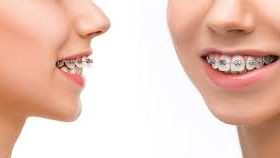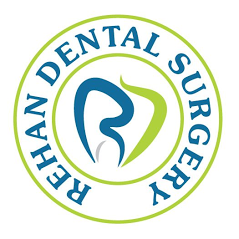





Dental Overbite in Karachi at Rehan Dental Surgery
Overbite medically refers to the extent of vertical superior-inferior overlap of the maxillary central incisors over the mandibular central incisors, measured relative to the incisal ridges.
The term overbite does not refer to a specific condition, nor is it a form of malocclusion. Rather an absent or excess overbite would be a malocclusion. Normal overbite is not measured in exact terms, but as a proportion (approximately 30–50% of the height of the mandibular incisors) and is commonly expressed as a percentage.
Other terms confused with “overbite”
Overbite is often confused with overjet, which is the distance between the maxillary anterior teeth and the mandibular anterior teeth in the anterior-posterior axis.
“Overbite” may also be used commonly to refer to Class II malocclusion or retrognathia, though this usage can be considered incorrect. This is where the mesiobuccal cusp of the maxillary first molar is situated anterior to the buccal groove of the mandibular first molar; in other words, the mandible (lower jaw) appears too far behind the maxilla. A person presenting with Class II malocclusion may exhibit excessive overbite as well, or may have the opposite problem, which is referred to as openbite (or apertognathia). In the case of apertognathia, the teeth do not overlap enough or at all—the upper teeth protrude past the lower teeth.
Causes
Overbite teeth are often hereditary. Jaw shape, like other physical features, can be passed down through generations. Childhood habits, such as thumb-sucking and pacifier use, are some other possible causes of buck teeth.
Overbite teeth from thumb-sucking
Your parents were telling the truth when they warned you that sucking your thumb could cause buck teeth.
Thumb-sucking is referred to as non-nutritive sucking behavior (NNSB), meaning that the sucking motion isn’t providing any nutrition as it would from nursing.
When this continues past the age of 3 or 4 or while the permanent teeth are appearing, the pressure created by the sucking and the finger can cause the permanent teeth to come in at an abnormal angle.
Overbite teeth from pacifier
Sucking on a pacifier is another form of NNSB. It can cause an overbite the same way that sucking on a thumb can.
According to research published in 2016 in the Journal of the American Dental Association, pacifier use was associated with a higher risk of developing malocclusions than finger- or thumb-sucking.
Tongue-thrusting
Tongue-thrust occurs when the tongue presses too far forward in the mouth. While this usually results in a malocclusion known as “open bite,” it can also sometimes cause an overbite.
The condition is most common in children, but it can carry on into adulthood.
It can be caused by a number of things, such as chronically swollen adenoids or tonsils and poor swallowing habits. In adults, stress can also cause it. Some adults thrust their tongue during sleep.
Genetics
Some people are born with an uneven jaw or a small upper or lower jaw. An overbite or prominent front teeth are often hereditary, and your parents, siblings, or other relatives may also have a similar appearance.
Missing teeth, extra teeth, and impacted teeth
Spacing or crowding can change the alignment of your front teeth and cause the appearance of buck teeth. Missing teeth allows your remaining teeth to shift over time, affecting the position of your front teeth.
On the flip side, not having enough space to accommodate teeth can also causes alignment issues. Crowding can occur when you have extra teeth or impacted teeth.
Health risks of Overbite
An overbite may cause health issues depending on how severe it is and whether it prevents a normal bite.
An overbite can cause issues including:
- speech impediments
- breathing issues
- chewing deficiencies
- damage to other teeth and gums
- pain when chewing or biting
- alterations in the appearance of the face
Treatment
Unless your overbite is severe and causing discomfort, treatment isn’t medically necessary. If you’re unhappy with the appearance of your teeth, you’ll need to see orthodontist at Rehan Dental Surgery for treatment.
There is no one standard way to treat overbite teeth because teeth come in different sizes, and bite types and jaw relationships vary from person to person. A orthodontist at Rehan Dental Surgery determines the best treatment plan based on your needs.
Braces
Traditional wire braces and retainers are the most common treatment for buck teeth.
Many people get braces in childhood or during their teenage years, but adults can benefit from them, too. Metal brackets and wires attached to the teeth are manipulated over time to gradually move the teeth for a straighter smile.
Tooth extraction is sometimes recommended if more room is required to straighten the teeth.
Palate expansion
Palate expansion is usually used to treat children or adolescents whose upper jaw is too small to accommodate adult teeth.
Follow Us

Telephone No.(021)34924052
